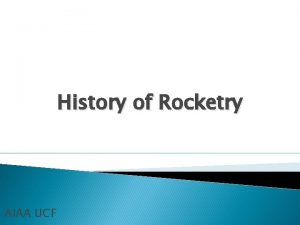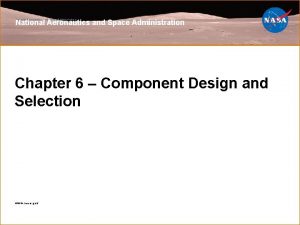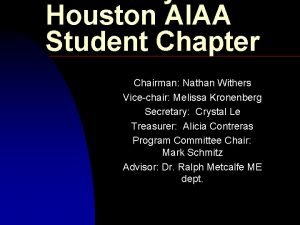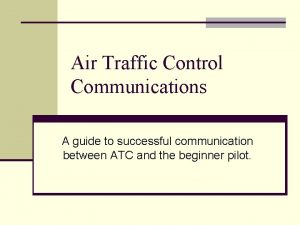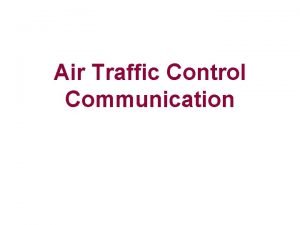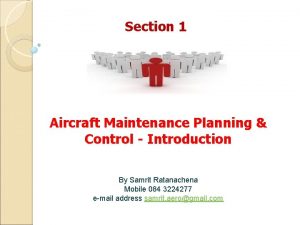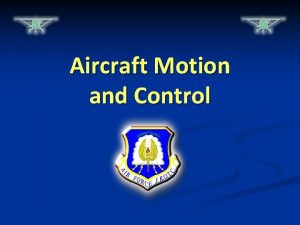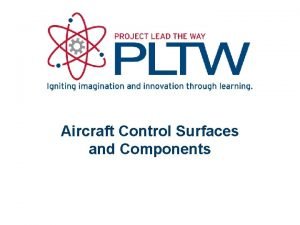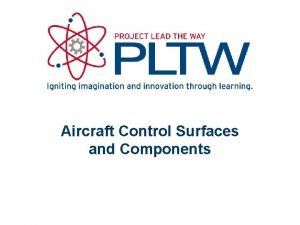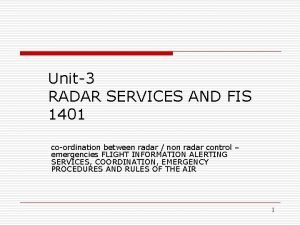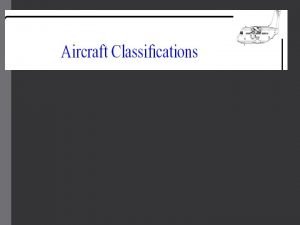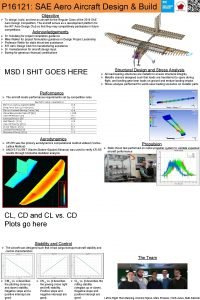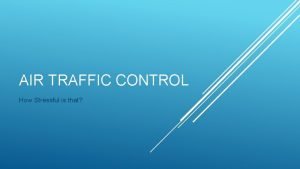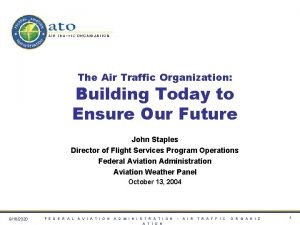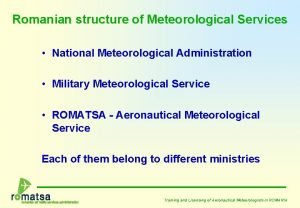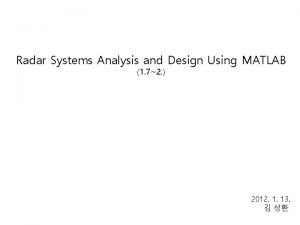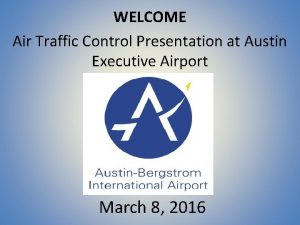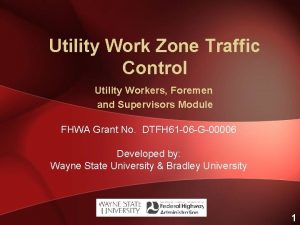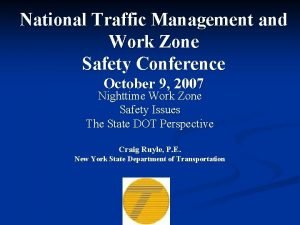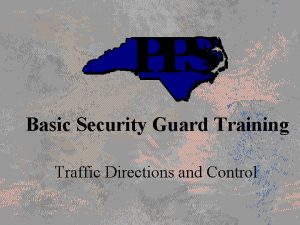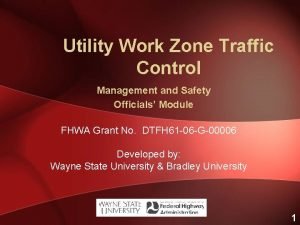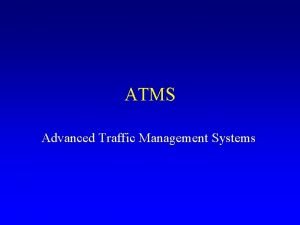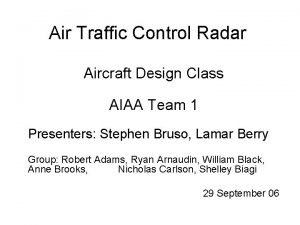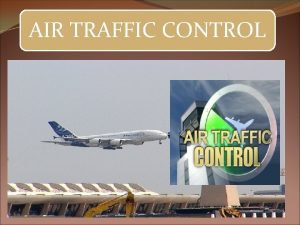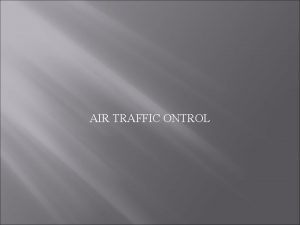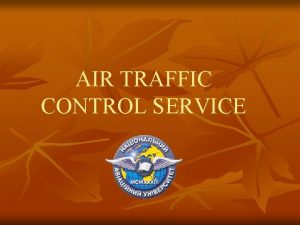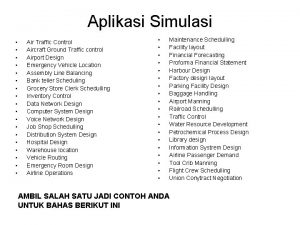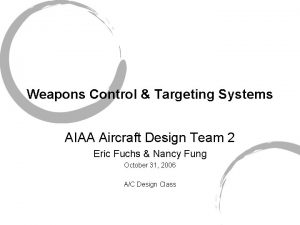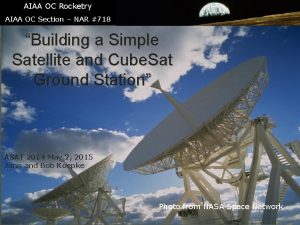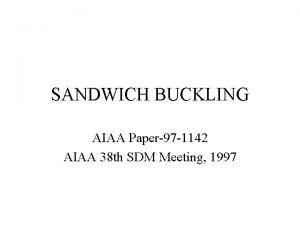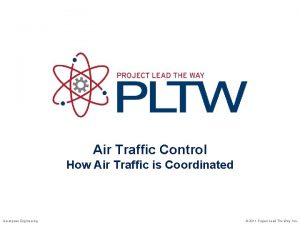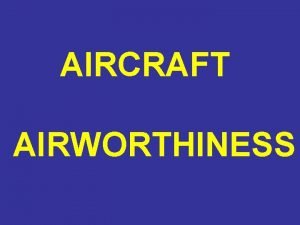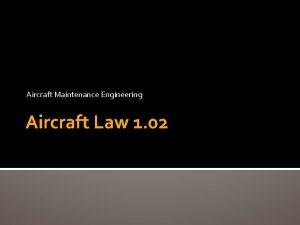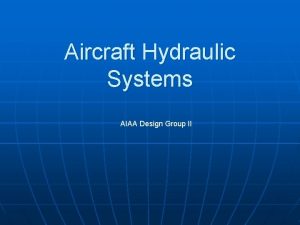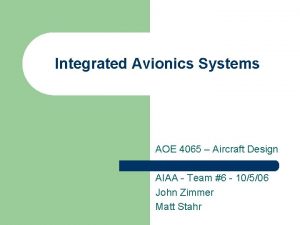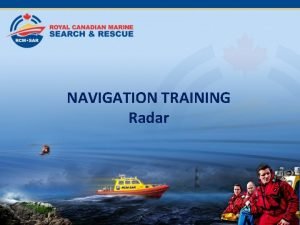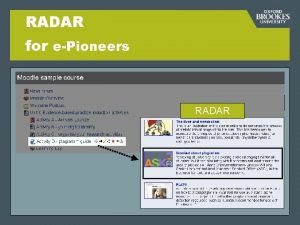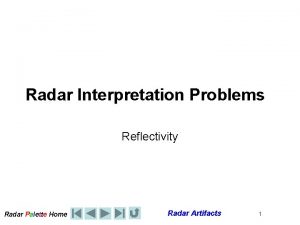Air Traffic Control Radar Aircraft Design Class AIAA






























- Slides: 30

Air Traffic Control Radar Aircraft Design Class AIAA Team 1 Presenters: Stephen Bruso, Lamar Berry Group: Robert Adams, Ryan Arnaudin, William Black, Anne Brooks, Nicholas Carlson, Shelley Biagi 29 September 06

Overview n n n n Why we need Air Traffic Control (ATC) History Identify Friend or Foe (IFF) Air Traffic Control Beacon System (ATCBS) Transponders Mode S Traffic Collision Avoidance System (TCAS) Radar

History Timeline n World War I Pilots begin taking radios into planes n 1920's - Airlines use radio to transmit weather information to pilots n 1921 - Army deployed rotating beacons in a line between Columbus and Dayton, OH n 1932 - Department of Commerce constructed 83 radio beacons that transmitted directional beams n 1935 - First air traffic control tower established at the Newark International Airport in NJ n World War II - Americans developed IFF (Identify Friend or Foe), installing transponders above Allied aircraft n 1958 - Federal Aviation Agency, charged with establishing and running an air traffic control system

Notable Accidents Grand Canyon, June 30, 1956 n United Airlines DC-7 collided with a TWA Constellation 128 passengers killed. The aircraft were flying in uncontrolled airspace, under visual flight rules New York City, Dec. 16, 1960 n United Airlines DC-8 and a TWA Super Constellation over New York City killed 128 people on board and 8 people on the ground. The United flight had experienced partial navigation equipment failure but failed to report it to the air traffic controllers.

New York City Dec 16, 1960 From Massachusetts Institute of Technology webpage

Notable Accidents Hendersonville, NC, July 19, 1967 n Piedmont Airlines B-727 collided with a private Cessna, 82 people killed. Accident was closely tied to lack of secondary surveillance radar and confusing transmissions by the air traffic control Cerritos, CA, August 31, 1986 n Aeromexico DC-9 with 64 passengers collided with a private Cessna aircraft carrying a family of three. The DC -9 crashed into a neighborhood and destroyed 18 homes and killed 15 people on the ground. The accident was blamed on inadequate radar approach and departure equipment and procedures.

Cerritos, CA, August 31, 1986 From Massachusetts Institute of Technology webpage

IFF n n A ground-based transmitter, the interrogator, broadcasts a radio signal to the aircraft A transponder on the aircraft would receive and reply to this signal Interrogations used very specific types of signals (1030 and 1090 MHz) If a plane did not respond correctly the system determined that the target was an enemy aircraft

ATCRBS n n System shares the same frequency bands as IFF A sensor on the ground sends out an interrogation signal (1030 MHz) from a rotating antenna to aircraft flying in its sector Aircraft equipped with transponders receive these interrogations and send back a reply (1090 MHz) There are two primary types of interrogations n n Mode A interrogations are used for plane identification information Mode C interrogations are used for altitude information

Problems with ATCRBS n ATCRBS uses a rotating antenna to continuously send out interrogations n An aircraft can be interrogated up to 20 times per sweep n Each time, the transponder sends back a separate reply n Causes interference and overload in the 1030/1090 MHz channels n When interference occurs the ground station receives garbled signals n As traffic increases, the number of airplanes at a given time within the antenna's interrogation beam will increase

Transponders n Mandated if aircraft flies above 10, 000 ft or within 30 miles of a major airport n Primary Surveillance Radar (PSR) transmits radar energy detected by the aircraft by reflected radar energy n Aircraft return is displayed on the ATC console at a range and bearing with aircraft position n The Secondary Surveillance Radar (SSR) transmits a series of interrogation pulses received by the aircraft transponder n Transponder replies with a different series of pulses that gives aircraft identifier and altitude n PSR and SSR are synchronized, both returns will be displayed on the ATC console

How everything works From Civilian Avionics Systems, Fig 6. 13

Mode S n Discrete Address Beacon System (DABS) later renamed Mode S n S=Select: uses discrete addressing to interrogate just one aircraft n Is a Secondary Surveillance Radar (SSR) beacon n Ground-air-ground data link system n Uses sophisticated monopulse techniques to determine azimuth bearing of aircraft

Mode S Interoperability n Several specific design decisions that were influenced by interoperability: n Frequency - 1030/1090 MHz was made so Mode S and ATCRBS could communicate on the same channel n Modulation - chosen partially to minimize the effects of interference due to shared frequency channels n n Signal Formats - the Mode S signal itself had to be designed so that it was transparent to existing transponders Error Correction - ATCRBS limitations forced the Mode S signal to be short, so parity and addressing bits were overlaid to maximize data block size

Mode S Frames n Transmission between transponder and station use 56 or 112 bit format called frames n Three Main categories: n n n 56 bit Survellience formats 112 bit communication format with 56 bit data field 112 bit communication format with 80 bit data field

Planned Improvements n Two major Preplanned Product Improvements currently underway n n Technology upgrades from 68020 to 68040 processors, currently in keysite test at Grand Junction, CO Traffic Information Service (TIS), a data link service that assist general aviation (GA) pilots in visual acquisition of surrounding air traffic by delivering automatic traffic advisories to the pilot, currently in keysite test at Dulles and Andrews AFB

Mode S Antenna Site From Massachusetts Institute of Technology webpage

Traffic Collision Avoidance System n Tracks up to 30 aircraft, displays the 25 highest priority aircraft n All commercial aircraft must be equipped with TCAS by 1993 n Uses three separate systems to plot positions of nearby aircraft n Directional antennae receives Mode S transponder signals to provide a bearing to neighboring aircraft, accurate to a few degrees of bearing n Mode C used to plot the altitude of nearby aircraft n The timing of the Mode S interrogation/response protocol is measured to find the distance of an aircraft

TCAS I n Gives the pilot relative position and velocity of all aircraft within a 10 -20 mile range n Has a traffic advisory capacity which provides a warning when an aircraft in the vicinity gets too close n Does not provide instructions on how to maneuver in order to avoid the aircraft n Warns aircraft of other aircraft within +-8700 ft of aircraft’s own altitude n Selected range n n n 15 -40 n miles forward 5 -15 n miles aft 10 -20 n miles each side

TCAS II n n Provides pilots with airspace surveillance, intruder tracking, threat detection, and avoidance maneuver generations Determines whether each aircraft is climbing, descending, or flying straight and level, and suggests an evasive maneuver Evasive maneuvers are coordinated via air-to-air transmissions so the proposed maneuvers will not cancel each other out TCAS II Change 7, software changes and updated algorithms that alter operating parameters

Types of Radar n Altimeter n Doppler n Weather

Altimeter n n n Radar transmissions to reflect off the surface immediately below the aircraft Provides absolute reading of altitude Differs from barometric or air data altimeter, which commonly reference sea level altitude n Operates over a max range of 0 – 5000 ft n Display shown has a max reading of 2000 ft

How an Altimeter Works From Civilian Avionics Systems, Figs 5. 27, 5. 28

Doppler n n n n Transmits energy through 3 or 4 beams skewed to the front and rear of the aircraft Radiated energy is reflected from the terrain Forward facing beams return a higher frequency, with the increase being proportional to the aircraft ground speed Aft facing beams returns a lower frequency Beams also detect lateral frequency difference from cross wind Sensitivity is 30 Hz per knot of speed Horizontal velocity error is on magnitude of 0. 015 per cent per degree of error in pitch angle Common on helicopter, however GPS has phased it out of transport aircraft

How Doppler Works From Civilian Avionics Systems, Fig 5. 31

Weather n Radiates energy in narrow beam reflected by clouds n Beam width of ~3 deg n Antenna maybe tilted in elevation around +-15 deg from horizontal, some have automated tilt n Displays are typically in color n Transmitter operates at 9. 345 GHz n 3 Basic Modes n n n Weather and map, with max range of 320 n miles Turbulence (TURB) mode out to 40 n miles Wind Shear detection out to 5 n miles

Weather Radar From Civilian Avionics Systems, Fig 5. 32

Summary n n n n Why we need Air Traffic Control (ATC) History Identify Friend or Foe (IFF) Air Traffic Control Beacon System (ATCBS) Transponders Mode S Traffic Collision Avoidance System (TCAS) Radar

Sources n http: //www. tc. faa. gov/its/cmd/visitors/data/ACT 300/modes. pdf n http: //mit. edu/6. 933/www/Fall 2000/modes/index. html n http: //www. faa. gov/ATpubs/ATC/INDEX. HTM n Book Civilian Avionics Systems, author Ian Moir and Allan Seabridge, AIAA education series, copyright 2003

? ? ? Questions ? ? ?
 Ucf aiaa
Ucf aiaa Aiaa s-114
Aiaa s-114 Www.aiaa-houston.org
Www.aiaa-houston.org Limitations of mti radar
Limitations of mti radar Mti vs pulse doppler radar
Mti vs pulse doppler radar Air traffic control alphabet
Air traffic control alphabet Air traffic communication
Air traffic communication Inbound traffic vs outbound traffic
Inbound traffic vs outbound traffic All traffic solutions
All traffic solutions Air higroskopis air kapiler dan air gravitasi
Air higroskopis air kapiler dan air gravitasi Aircraft maintenance planning
Aircraft maintenance planning Aircraft motion and control
Aircraft motion and control Aircraft control surfaces and components
Aircraft control surfaces and components Aircraft control surfaces and components
Aircraft control surfaces and components Sigmet volcanic ash
Sigmet volcanic ash Aircraft group classification
Aircraft group classification Aircraft design and build
Aircraft design and build Air traffic controller work hours
Air traffic controller work hours Traffic organization service
Traffic organization service Romanian air traffic services administration
Romanian air traffic services administration Radar systems analysis and design using matlab
Radar systems analysis and design using matlab Radar systems analysis and design using matlab
Radar systems analysis and design using matlab Traffic control austin
Traffic control austin Utility work zone traffic control
Utility work zone traffic control Driver education signs
Driver education signs Nysdot work zone traffic control manual
Nysdot work zone traffic control manual Traffic direction training
Traffic direction training Utility work zone traffic control
Utility work zone traffic control Atms traffic control
Atms traffic control Apache traffic control
Apache traffic control If 7 cards are dealt from an ordinary deck
If 7 cards are dealt from an ordinary deck
